Preventative Treatment Options for UTIs
In our research around the prevention of recurrent urinary tract infections (UTIs) it has become clear that UTIs are the result of a complex set of conditions, where genetics and the environment intersect in a myriad of possible ways. This means that preventative treatments have varying levels of efficacy for different people.
Preventative Treatments
There are many options for the preventions of Urinary Tract Infections, below is a list of some of the common ones, including a graph showing what level of effectiveness our customers found with each method. This is not a medical recommendation, and we suggest you take any options you are considering to your urologist, continence nurse or health professional.
- Low dose antibiotics
- Hiprex
- Gentamicin flush
- Bladder washes (Microdox, Suby G)
- D-Mannose
- Cranberry (as opposed to DMannose)
- Ural
- UTI vaccine
- Vitamin C
- Probiotics
- Hormone therapy
- Hydration (drinking lots of water)
- Vinegar
- Diet
- Chinese herbs
- Oregano oil
- Changed type of catheter
- Stopped re-using catheters
- Started re-using catheters
Low dose antibiotics
This treatment involves taking a small dose of antibiotics every day, to reduce and prevent bacteria from populating the urinary tract. Several different types of antibiotics may be prescribed, most commonly cephalexin or trimethoprim.
This approach was rated as the most effective by our survey respondents. Unfortunately, long term antibiotic usage may increase microbial resistance and adversely affect the gut microbiome.
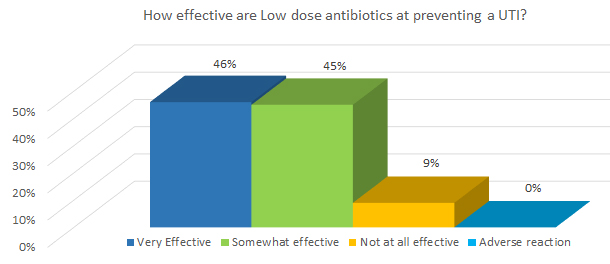
Hiprex
Hiprex tablets contain the active ingredient Methenamine Hippurate. This medication also contains an ingredient that helps to make urine more acidic. When the urine is acidic, methenamine turns into formaldehyde which aids in the destruction of bacteria. Your doctor may test the acidity of your urine and recommend dietary changes (adding Vitamin C or cranberry juice and reducing milk products and fruit) to increase urinary acidity. Hiprex is generally given as one 1 gram tablet twice a day.
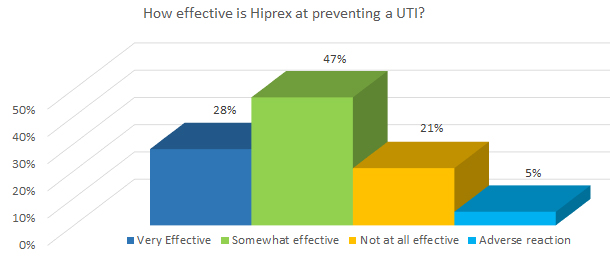
Gentamicin flush
Gentamicin is an antibiotic used to treat or prevent UTIs that are difficult to treat with oral antibiotics. A very high concentration of the medicine can be delivered directly to the bladder via a catheter. Gentamicin is an aminoglycoside antibiotic and isn’t absorbed by the bladder or intestines removing the risk of antibiotic resistance. Gentamicin can be obtained already mixed, or you can mix the solution together yourself. 30-60ml of the liquid is instilled in the bladder through a catheter and then left in the bladder until the next emptying. This is generally done at night so the drug stays in the bladder for the longer night time period.
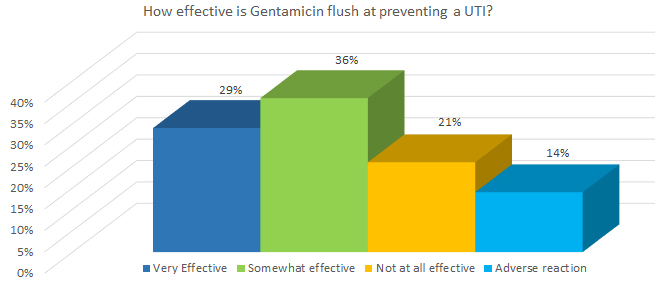
A very low number of respondents reported using this preventative.
Bladder washes (Microdox, Suby G)
There are a variety of solutions that may be used as bladder washes to prevent UTIs.
Microdox is any electrolysed bladder rinse solution that physically reduces UTI causing bacteria and biofilms. It is non-toxic and non-antibiotic so it does not promote bacterial resistance. Microdox comes in a ready to use solution and is instilled into the bladder directly via a catheter. The solution is left in the bladder for 10 minutes and then removed. Instillation is suggested daily as a prophylactic.
Suby -G is an irrigation solution for catheter maintenance. Suby G comes pre mixed in a bag complete with tubing to attach to a catheter and drain directly into the bladder. Suby-G should be at body temperature, instilled in the bladder and left for 5 minutes before being drained.
Paralogic sell Microdox, Suby G and other bladder irrigation solutions.
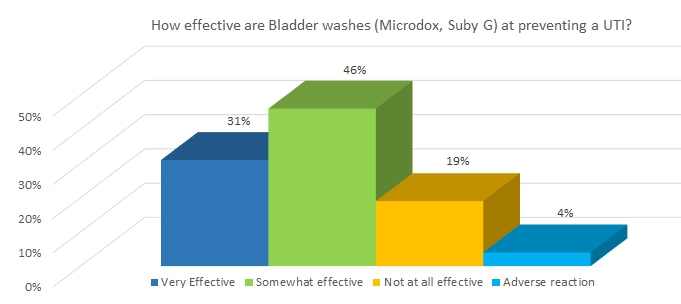
A very low number of respondents reported using this preventative.
D-Mannose
D-Mannose is a naturally occurring sugar that is found in fruits such as blueberries and cranberries. D-Mannose is absorbed by the upper gastro intestinal tract, travels through the blood stream to the kidneys and finally to the bladder where it helps cleanse the urinary tract and maintain a healthy bladder lining. In the urinary tract, D-Mannose attaches to UTI causing bacteria and prevents them from embedding in cells and causing infection. More research is needed, but it has been shown that D-Mannose can help to promote normal urinary tract function when taken on a regular basis. D-Mannose comes in a tablet and 2-3 1000mg tablets are recommended per day.
Paralogic sell UroFem D-Mannose.
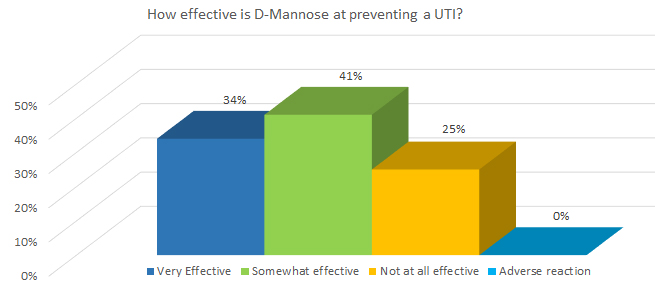
A very low number of respondents reported using this preventative.
Cranberry (as opposed to DMannose)
Cranberries have long been a popular home remedy for UTIs but studies as to the preventative benefits have had mixed results. There has been some evidence that cranberry juice may decrease the number of symptomatic UTIs over an extended time period – particular in those with recurrent infections. The current reasoning is that cranberries work by preventing the adhesion of bacteria (particularly E. coli which is the primary cause of UTI) to the urethral tract walls.
The recommended doses of cranberry products for the prevention of UTIs has been poorly defined, and concentration in various beverages vary. The most highly studied formulation has 25% pure juice and clinical research suggests that daily dosages of 240–300 ml of cranberry juice at this concentration can prevent 50% of the recurrences of UTIs and may reduce bacteria. Cranberry can also be taken as an extract in tablet form which may be more effective at obtaining the higher dose needed for bacteria suppression.
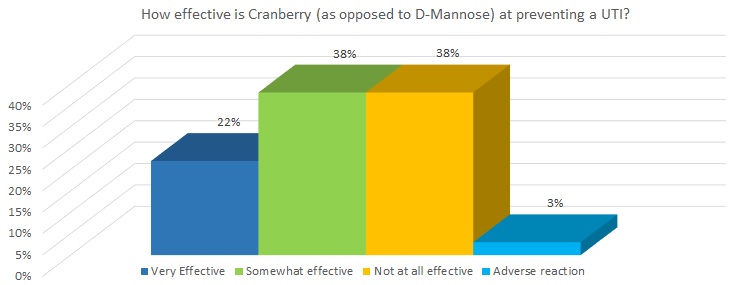
A low number of respondents reported using this preventative.
Ural
Ural is a urinary alkaliniser in powder form that is mixed with water and taken to make urine less acidic. This can reduce the burning sensation that comes with urination while suffering from a UTI. Reduced acidity in urine can also provide conditions that make it difficult for bacteria to survive. Evidence suggests that Ural may assist when taken very early in a UTI.
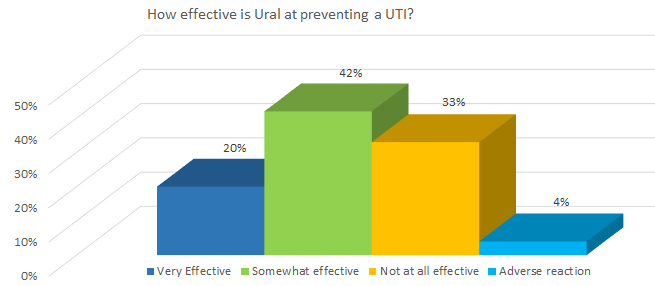
A low number of respondents reported using this preventative.
UTI vaccine
Vaccines promote the production of antibodies which act against specific bacteria, helping to strengthen the immune systems natural response when attacked. There are several promising UTI vaccines in development but it may be years before they are ready for widespread use.
Uro-vaxom is a preventative treatment taken as a 3-month regime that strengthens the immune systems response to E. coli bacteria which are known to cause most UTIs. This can also be taken in tandem with antibiotics as a treatment for acute UTI infection. This treatment has yet to be approved for use in many countries but there are more studies underway.
Uromune is an oral spray taken daily for at least 3 months and is said to prevent the four types of bacteria that commonly cause UTIs, E. coli, K. Pneumoniae, P. Vulgaris and E. Faecalis. This product can only be ordered by your doctor from New Zealand (where it is more widely available).
There are currently few studies to speak on the efficacy of these (and other) medications but reports from users indicate they may be beneficial in reducing UTIs as either a stand-alone treatment or when used in conjunction with other treatments.
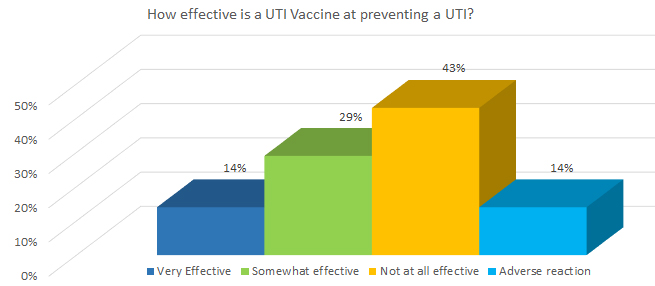
A very low number of respondents reported using this preventative.
Vitamin C
Ascorbic acid (vitamin C) is often recommended as a supplement that can prevent repeated UTI by acidification of the urine. Strong clinical evidence to support this claim in healthy adults is lacking. While a healthy vitamin C intake is essential for fighting infection, for many with bladder issues it can trigger irritation of the bladder. Vitamin C is water soluble and makes its way to the kidneys and into the bladder. Vitamin C causes conditions in the bladder to be more acidic which results in the production of nitric oxide. This nitric oxide can kill some of the bacteria that cause UTIs. While harmless in small doses, long term use at the higher doses that work again UTIs can cause side effects including stomach upset, pain, inflammation, fatigue and more.
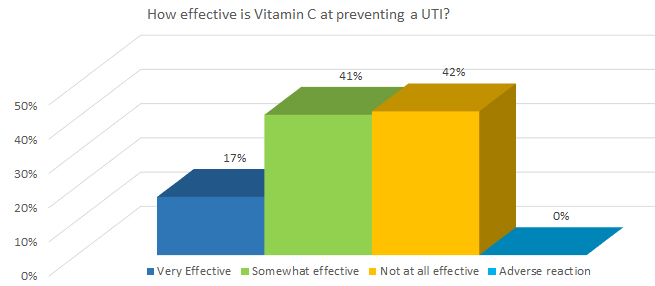
A low number of respondents reported using this preventative.
Probiotics
The ways in which probiotics might work for UTI have still not been thoroughly researched. Bacteria that infect the urinary tract typically originate in the intestine and travel from the anus to the urethral opening (most commonly in women). From there pathogens can travel to the bladder and kidneys. There are hundreds of microbial species found in the vagina, digestive system and bladder. When these microbes exist in healthy balance, pathogens find it difficult multiply. Probiotics may assist in preventing infection by maintaining optimal vaginal pH and producing antimicrobials to kill any incoming pathogens.
Probiotics can come in the form of vaginal pessaries or a Lactobacillus drink. As in many of the preventatives listed here, the scientific data on these studies is not clear cut. There is a challenge in that oral probiotics must survive and establish themselves in the gastrointestinal tract before they are capable of establishing a colony in the urinary tract.

A low number of respondents reported using this preventative.
Hormone therapy
Often, women who have been through menopause have an increased incidence of UTIs. The reduction in the amount of estrogen (the female sex hormone) common after menopause may lead to a reduction in protective substances that coat tissue in the bladder. In one study it has been found that women who were taking menopausal hormone therapy had more Lactobacillus (a helpful species of bacteria) in their urine. Estrogen also encourages the production of natural antimicrobial substances in the bladder. The hormone also reinforced the urinary tract by closing the gaps between the cells that line the bladder, making it harder for bacteria to penetrate the deeper layers of the bladder wall.
As a natural process, when infection sets in the top layer of bladder cells may die and shed, but with increased shedding bacteria can access deeper tissue. It has been found that estrogen encourages the redistribution of cells and prevents excessive shedding during an infection. There are significant risks and benefits to hormone therapy and further clinical trials are needed. Hormone therapy is generally taken as an oral supplement or via a patch - there is the option of vaginal estrogen therapy in which estrogen is administered topically but women who used this method may not have sufficient lactobacilli in the urine to make a difference to infection rate.
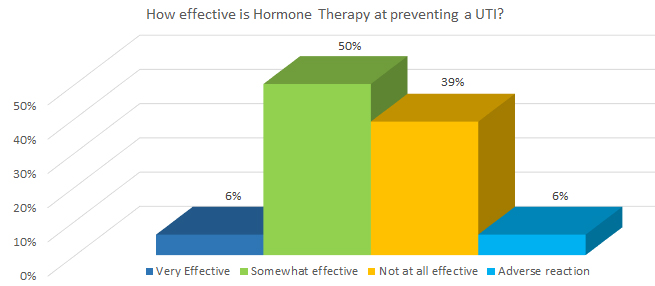
A very low number of respondents reported using this preventative.
Hydration (drinking lots of water)
Dehydration may increase the risk of UTI as additional liquids encourage the emptying of the bladder which cleans the urethra, removing bacteria. Much of the research done into this area involves increasing fluids in residents of care homes in an effort to reduce UTIs and studies have shown promise. Studies outside the nursing home environment have found that premenopausal women who have a low fluid intake and frequent UTIs can half the number on infections by drinking 2 extra cups of water with each meal. Increasing fluid intake to a minimum of 1.5L per day is an affordable and safe way to help reduce the risk of UTI.

Vinegar
Apple cider vinegar (ACV) is used as a home remedy to treat a variety of conditions, even though scientific studies thus far have tended to be lab or animal based. Apple cider vinegar is made by fermenting apple cider and the resulting acetic acid is thought to reduce infection causing bacteria. The belief is that ACV can help prevent further infection but will not cure an imbedded infection. ACV should always be diluted before digestion and should never be applied directly to skin. You can dilute ACV in water or tea (adding honey to sweeten if required), use ACV with olive oil as a salad dressing or add it to a warm bathe at a highly dilute rate (however even if you bathe in it, the ACV will not enter the urethra).

A very low number of respondents reported using this preventative.
Diet
Whilst diet can affect every part of you and is an integral part of a healthy lifestyle, there is a lack of scientific evidence showing specific associations between UTIs and dietary changes. There is growing evidence that obesity affects UTI occurrence with obese persons more likely to suffer from a UTI. Further studies are needed to determine whether weight loss can reduce UTI risk.
When it comes to what we eat and UTI occurrence, some studies have shown that a vegetarian diet can lower the risk of developing a UTI. Vegetarian diets make urine less acidic which can help prevent the growth of bacteria associated with infection. Beverages that act as bladder irritants like tea, coffee, alcohol and carbonated drinks can increase lower urinary tract infection symptoms but there is no quantifiable link connecting their dietary restriction to a lowered UTI incidence. Fresh juice, especially berries and consumption of fermented dairy products such as yoghurt have shown promising leads in reducing UTI risk.
There is a lack of strong evidence to suggest that diet is a useful way of avoiding UTI. But if you are a sufferer of recurrent infections, any positive changes in your diet should be considered. .

A very low number of respondents reported using this preventative.
Chinese herbs
There are anecdotal reports of people curing their chronic UTI using traditional Chinese medicine (TCM), independently or in combination with mainstream antibiotics. However scientific studies and results have not been forthcoming. There are examples of when patients have had a better result with TCM in conjunction with antibiotics than with antibiotics alone.
Chronic UTIs have a number of causes in Chinese medicine but the most common is Kidney Yin Deficiency. TCM is often used in conjunction with acupuncture – which has been shown to be highly effective for bladder pain due to interstitial cystitis.
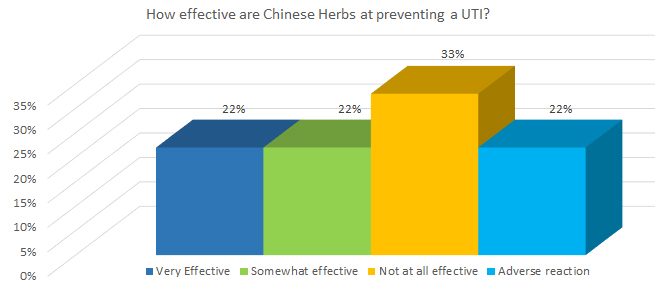
A very low number of respondents reported using this preventative.
Oregano oil
Carvacrol (CV) is a phenolic monoterpenoid found in essential oils including oregano (Origanum Vulgare) and has been shown in lab and animal studies to be effective against a variety of infections. Oregano oil has strong antibacterial and antifungal properties and can disrupt the bacterial cell wall, stop bacteria sprouting pili and stop bacteria from using existing pili to implant into the bladder wall.
Oregano oil can be taken as a tincture or in capsules and the recommended dose is about 500 mg of oregano oil four times daily. It is best to go for a food-grade brand that has a higher (60%) carvacrol concentration, but beware that manufacturing standards are not monitored. You should always check with a medical practitioner before taking any oils, especially if you are pregnant, or taking other medications.
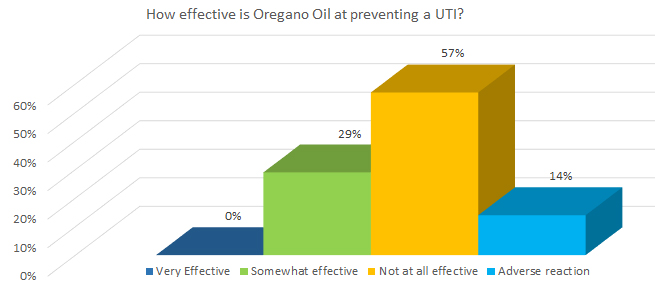
A very low number of respondents reported using this preventative.
Changed type of catheter
Changing the type of catheter you use, from an intermittent catheter (single use thrown away after insertion and removal) to an indwelling catheter (inserted through the urethra or abdomen wall and left in the bladder for several weeks) or vice versa may result in changes to your UTI status. However, changing the way in which you catheterise is more likely to be recommended for reasons other than infection.
Some people may also find relief in using different single use catheters (pre-lubricated, integrated bag etc) or by changing their preparation and hygiene methods. It is always worth talking to your medical profession to make sure you are using the product best suited for your needs.
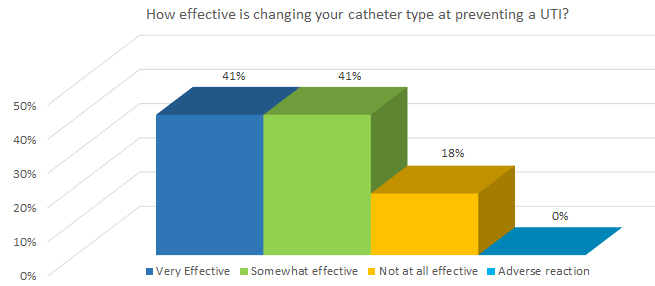
A very low number of respondents reported using this preventative.
Stopped re-using catheters
Many Paralogic customer have reported re-using single use catheters for days, weeks or sometimes (but rarely) months. In most cases this is a result of the cost associated with using a catheter once only, although many customers report having to do this on occasion when they run out of product and are waiting for a delivery. Still other customers have received advice from medical professionals to sterilise and reuse single use catheters.
Although in some people it does not cause a problem, there is an increased risk of infection including UTIs in whatever way you are reusing single use catheters. At Paralogic we have done our best to offer affordable catheters that allow many customers to use them only once and this is reportedly effective at reducing UTIs. It should be noted that the introduction of the NDIS has meant many people who were once reusing catheters are now able to afford to use a new catheter every time.
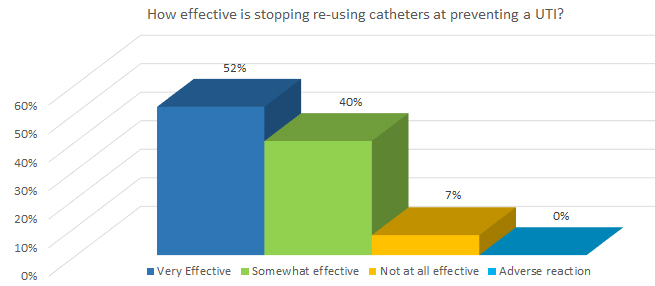
A very low number of respondents reported using this preventative.
Started re-using catheters
In a limited number of people, reusing catheters has no effect on infections and some people even state that reusing catheters has resulted in better UTI prevention.
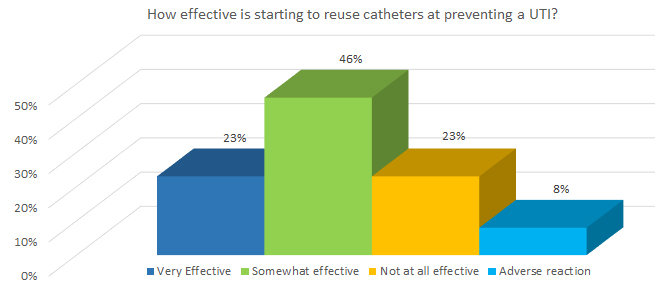
A very low number of respondents reported using this preventative.
Disclaimer
These statements have not been evaluated by the Australian Therapeutic Goods Administration or any medical professional and are not designed as medical recommendations. Please speak to a medical professional about any of the above before making changes.
 |
Return to the landing page for UTIs |
Comments (4)
Re accruing
10 December 2025I’ve been battling UTIs now for 10 years , sometimes back to back to back UTIs that last months . I’ve tried every remedy . I really think the bacteria gets into the wall of the badder even the urethra canal and embeds itself dodging Antibiotics. I feel I’m fighting an infection constantly, fatigue, no motivation and just feel quite off and anxious . I’ve gone full carnivore to no improvement, tried vego . I’m at my wits end now its effected all aspects of my life . I’m still searching and hoping success is around the corner to help people life myself . I believe in the UK they are using a vaccine but I’m not upto date with its progress here in Australia. Anyway hope you get better .
Self Catheterisation
10 November 2021Well done with releasing the results of the survey. I suspect it gives people ideas on what may work for others. Anyway , I suggest those who self catheterise attempt to pass some urine 1st urethrally as bacteria are most prevalent in the 1st few cms no matter what. The passing of urine does decrease the bacteria significantly. I use alcohol wipes to reuse - $5 for 100. I also use them to introduce the catheter. Important to clean a used Cath well initially then and after reusing replacing it back in its sterile packaging. Physically wiping with the swab I suspect removes the most of the bacteria with the alcohol killing the bacteria due to longer contact times in the swab. Also let the alcohol dry evaporate as it’s a bit toxic to urethral cells. This is very quick which also makes the wiping important due to the low contact time. Hold the catheter as far away from the tip as possible and use lots of gel. Seems to work for me but I limit my reuse to 2 daily One overnight then one for the day. Seems to work for me both financially and environmentally. Kind Regards Richard . Ps Thankyou for providing a great service also with prices that are the best.
Time for doctors to consider all options
9 November 2021Recurrent infections are taking their toll. I need to start trying to help myself and try experimenting with alternative measures. While the medical fraternity remain dubious of most alternative treatments, now that I'm travelling the road of antibiotic resistance, I need to step up for myself. I am thankful for the survey results. I do understand that there is much more research to be done.
Thank-you survey results
9 November 2021. Many thanks for circulating the results of the survey in conjunction with the information provided about products. Since Norm has been taking cracranberry tablets daily, he has not experienced anyUTIs of significance . Kind regards Valerie
